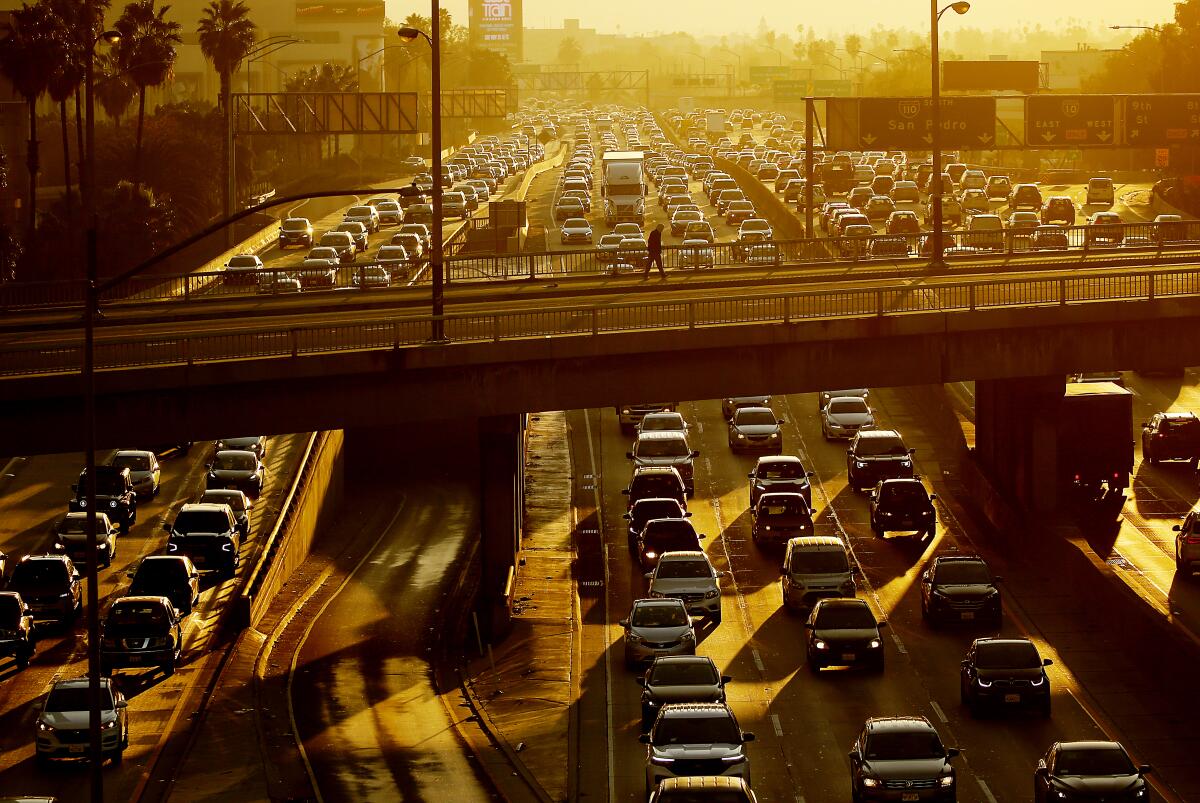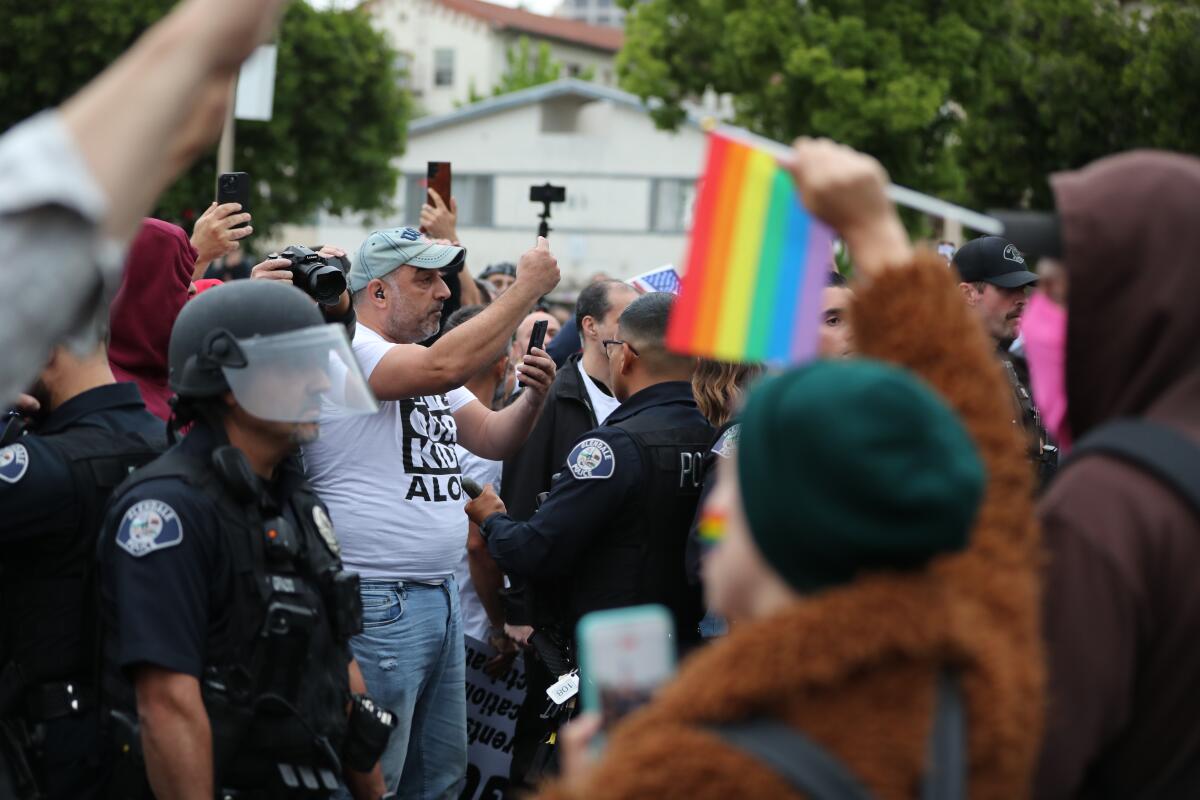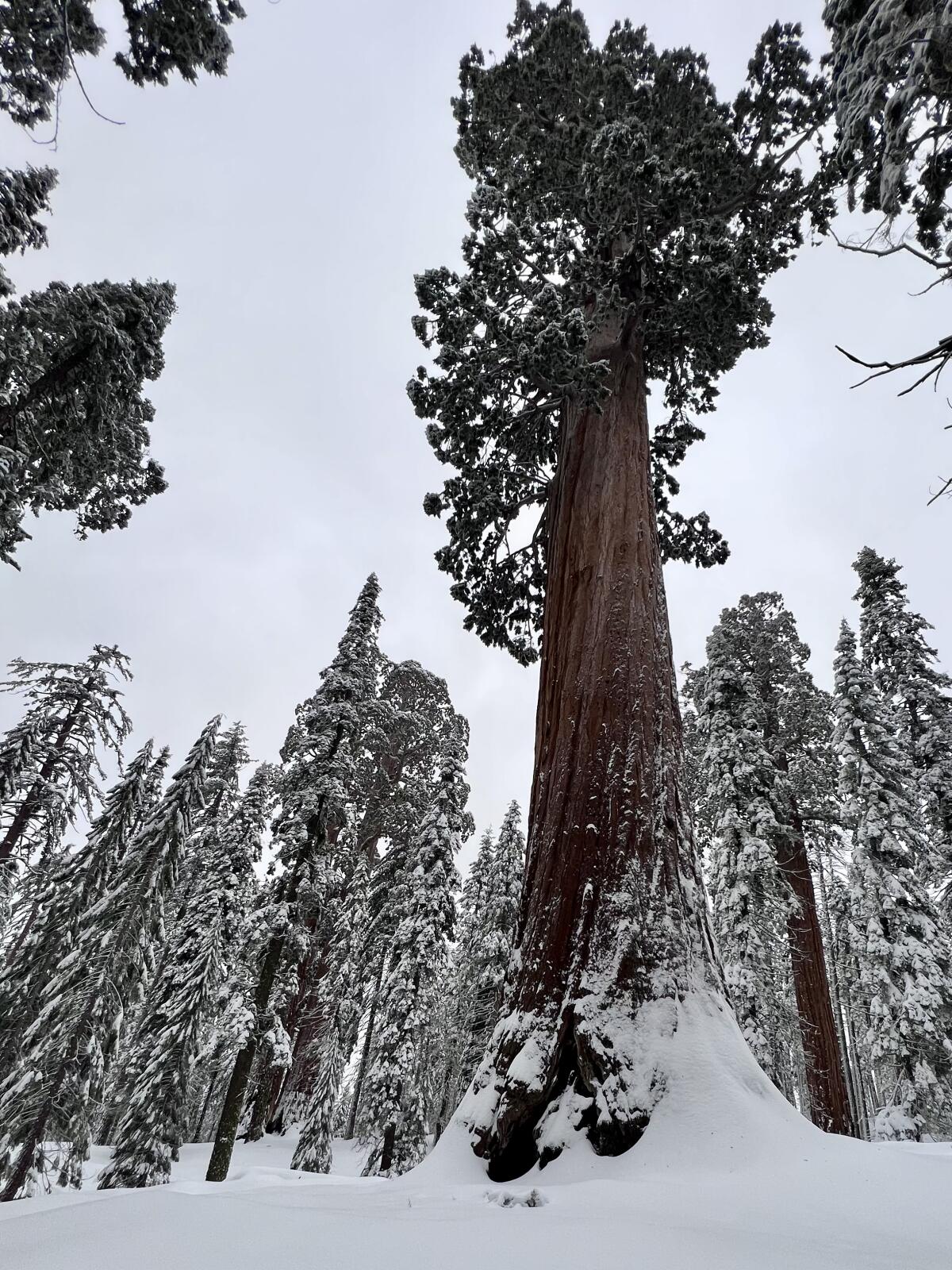‘Hell no,’ ‘OMG yes’ and more reader thoughts on congestion pricing

- Share via
Good morning, and welcome to the Essential California newsletter. It’s Thursday, June 8.
Last week, I highlighted L.A. County transportation officials’ plan to explore congestion pricing — charging drivers to access key routes at high-demand travel times — as a way to reduce our region’s infamous traffic.
A few high-traffic zones are being considered as part of a pilot program:
- Along the 10 Freeway between downtown and Santa Monica
- On arterial streets and freeways around downtown Los Angeles
- Through the canyon streets and freeways that link the San Fernando Valley to West L.A. and the rest of the basin
L.A. Metro officials haven’t released many details about the plan, including how much they might charge drivers. A fact sheet published by the agency in late 2022 mentions similar programs in London and Stockholm that had success in reducing congestion. London charges drivers £15 per day for driving in active congestion charge zones, or roughly $18.66. Stockholm has an hourly fee table with a daily maximum of 135 Swedish Krona, or about $12.39.
We asked readers to weigh in, and you sure had some thoughts. Responses ranged from exuberant support, to some maybes and only-ifs, to adamant opposition, including an unambiguous “F— NO.”
Some of those against made an equity argument, saying congestion pricing would fall hardest on low-income residents and worsen the region’s economic inequities.
“This is a classist solution that will only further divide Los Angeles into the haves and the have-nots,” said Bridget H., of Pasadena. “Low income and middle class people are already nearly priced out of living here — this will only further exasperate the financial strain many are dealing with.”
We’ll get a better sense of how L.A. Metro plans to address those equity concerns once they release their feasibility study, expected this summer. Officials previously said the pilot program would include subsidies for low-income drivers and carpoolers, plus funding that would create alternatives to car travel.
Those alternatives are seen as key to a less-congested future as Metro works to expand its public transit network and build more active transportation infrastructure. The goal is that making those options more competitive with driving will lead more commuters to ditch their cars for buses, bikes and trains.
Some readers told us they’d be more willing to take transit instead of driving if they felt the system were safer. But some would still rather drive. Emily N. said she felt that driving a car “is much safer than using public transportation or riding a bike.”
That sense of safety is a key reason people cite as keeping them off public transit — particularly women, according to Metro surveys. But traffic violence on L.A. County’s road has an enormous toll.
L.A. Metro officials reported more than 1,500 Part 1 crimes — the category that includes homicide, rape, aggravated assault and robbery — on its system in 2022. More than 1,700 Part 2 crimes were also reported, which includes crimes like stalking, vandalism, and assault that did not include a weapon or serious injury. Both types increased from 2021. The agency reported 21 deaths on its system last year, with six of those a result of violent crime.
That same year, 704 people were killed in traffic crashes in L.A. County, according to state data compiled by UC Berekely. More than 3,600 other people were seriously injured in collisions.
I don’t note this to minimize anyone’s experience or sense of safety riding public transit. I’ve previously heard from dozens of women who shared harrowing experiences on Metro’s system. But many more people in cars or who share space with cars are hurt or killed than people using public transit.
Some of you expressed support for the idea, saying a fee to make your commute less of a hellscape would be worth it.
“Congestion pricing works in other places — people consolidate their trips or go at less crowded times [or] choose to take the train or bus instead,” said Long Beach resident Erin. H. “I am willing to pay if it means less sitting in traffic.”
For L.A. resident Jason W., L.A.’s motoring public “needs a stick to go with the few carrots inducing alternative transit habits.”
Still, some aren’t too optimistic the region’s public transit infrastructure will improve enough to be competitive with car trips.
“The only thing that might incentivize me to choose transit or another mode of travel is if the logistics and convenience factors were just too good to resist,” wrote Katherine W. of Downey. “But I just do not see that ever happening.”
Here’s more of what readers had to say (edited for clarity and brevity).
“I suspect I am one of the few who would support congestion pricing. I want people to use public transportation and to care about the climate and other environmental impacts of their driving. Perhaps a combination of free public transit and simultaneous congestion pricing would help pry people out of their vehicles.”
— Pamela M., San Diego
“Unlike some, I do not have the privilege to choose what time my commute is. This is based on my job, which I cannot change. Already I am paying for crazy things like gas, food and shelter. I cannot afford more expenses, no matter how small.”
— Elisabeth O., Santa Clarita
“People have no viable alternatives. The light rail system isn’t robust enough or extensive enough. In European cities a person can walk five to 10 minutes to board a train or bus departing every few minutes. We are nowhere close to that in Southern California.”
— Jan B., Irvine
“There are simply too many cars on the road. Heavy traffic can easily increase my commute time by 250%. I also live very close to a freeway and the noise level increase has become unbearable, in addition to the pollution. Perhaps the money generated could be used to fund better trains that run faster like in Europe and Asia.”
— Kris S., Los Angeles
“Why punish 9-5ers who can’t do anything about the standard time of their workday? If a senior citizen needs to see a doctor, and the only appointments available are during congestion pricing, should that senior on a fixed income have to suffer?”
— Lynne M., Pacific Palisades
“As long as the money went toward improving public and other transportation options. It needs to be far more convenient to NOT drive, like in NYC, in order to solve this problem.”
— Elizabeth B., Los Angeles
“So we’re just going to let rich people drive on the roads and price poor people out? No wonder politicians wanted to keep their name off of this until after the elections. Without providing any great alternatives for people who live within L.A., this is just a slap in the face.
— Laila T., Los Angeles
“It is my choice to have a job that is 66 miles away from where I live. It is not fair to the communities that I drive through that they should have to breathe all of the pollution I create without some form of compensation. Not only that, but even the people who don’t drive suffer due to me being on the highway, because they have to pay tax used to fund the highways that could be spent on other infrastructure or improvements.
— Kurt C., Long Beach
“We already pay registration fees and gasoline tax so that we have open access to the freeways and roadways. We don’t need any more fees or taxes in California. Forget that idea, and I will not vote for any politician who suggests this. If you don’t like driving on a congested roadway, use some self-discipline and plan your trip during off-peak hours.”
— Robert R., Monrovia
“It disproportionately affects workers who have been gentrified out of work centers or are just entering the job market and not earning enough to support living near work.”
— Carlos O. of Long Beach
“Many people will have strong feelings against it because they fear change, but I’m all for it. We need to stop being a car-centric society (thanks, car companies) and move forward.”
— Ricky I., Los Angeles
And now, here’s what’s happening across California:
Note: Some of the sites we link to may limit the number of stories you can access without subscribing.
L.A. STORIES
Our newsroom is reeling today after devastating news from Los Angeles Times’ management that 74 people on staff are being targeted for layoffs. The newspaper’s leadership has cited “budget and revenue challenges” facing the media industry at large. Los Angeles Times

A Glendale Unified School District board meeting that included a vote to recognize Pride Month brought dueling demonstrations, leading to a street brawl and three arrests. Anti-LGBTQ+ activists voiced outrage about school curriculum related to gender and sexuality, while district officials say “intentional and harmful disinformation” has been spread by conservative groups. Los Angeles Times
An L.A. mystery is back on doorsteps in Highland Park. Unsolicited food deliveries from Uber Eats have resumed again, following a nearly two-month lull. Last time around, residents in the neighborhood received dozens of unwanted orders, many from McDonalds and Starbucks. Los Angeles Times
POLITICS AND GOVERNMENT
Florida Gov. Ron DeSantis’ administration has confirmed they orchestrated charter flights transporting dozens of migrants to Sacramento. Government officials, local church leaders and nonprofit groups have stepped in to help them, saying the migrants were deceived and did not know they were being taken to the state’s capital. Los Angeles Times
Orange County’s Board of Supervisors approved a new flag policy this week, limiting displays on county sites solely to government flags. LGBTQ+ advocates had been pushing supervisors to allow Pride flags to fly as a symbol of inclusion. The Orange County Register
HOUSING AND ECONOMY
New census data show renters occupied 45.5% of California housing units in 2020. But the state’s high cost of housing means few people can afford to live alone. The state is second-to-last in the rate of single-occupancy households. Los Angeles Times
A recent study from United Ways of California shows a third of families in the state don’t earn enough to afford basic needs. The study found that Latino and Black households struggle the most, with more than 51% and 45% of families respectively falling below their “real cost” metric, which includes life expenses like housing, healthcare, child care and transportation. The Sacramento Bee
Support our journalism
HEALTH AND THE ENVIRONMENT
The formerly dead Tulare Lake has grown to nearly the size of Lake Tahoe, according to new state estimates. Officials don’t expect the lake to get any bigger and say earlier projections about catastrophic flooding have been eased by cooler weather and a less dramatic snowmelt. San Francisco Chronicle
An unusually large pod of orcas was spotted celebrating a hunt off San Francisco’s coast last month. Researchers say the meetup near the Farallon Islands could have included six or seven separate families, attracted by a buffet of sea lions and harbor seals. They don’t call them killer whales for nothing. Los Angeles Times
Free online games
Get our free daily crossword puzzle, sudoku, word search and arcade games in our new game center at latimes.com/games.
AND FINALLY
Today’s California landmark comes from Devin Vance of Fresno: the towering General Grant tree in Kings Canyon National Park.

Devin writes:
[It’s] the namesake of the Grant Grove of giant sequoias, and is recognized as the nation’s Christmas tree. This tree is nearly 270 feel tall, over 100 feet around at the base, and thought to be over 1,600 years old — crazy measurements for a living thing! It is the biggest tree in the grove, but there are many others that keep it company along this easy hike through these giants. I’ve hiked through here many times and it still makes me feel small. It’s especially special to me because I was married beneath it, so it was my best man.
What are California’s essential landmarks? Fill out this form to send us your photos of a special spot in California — natural or human-made. Tell us why it’s interesting and what makes it a symbol of life in the Golden State. Please be sure to include only photos taken directly by you. Your submission could be featured in a future edition of the newsletter.
For the record: The Tuesday, June 6, edition of Essential California misspelled the name of Times reporter Ruben Vives.
Please let us know what we can do to make this newsletter more useful to you. Send comments to essentialcalifornia@latimes.com.
Sign up for Essential California
The most important California stories and recommendations in your inbox every morning.
You may occasionally receive promotional content from the Los Angeles Times.







